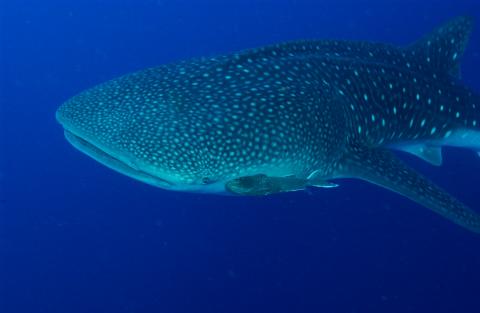
Historically, the whale shark has been hunted for its meat and liver oil. Whale shark fins are considered inferior in quality and the species is generally not targeted for its fins, although a market for them does exist in Asia due to their massive size (Norman 2005). Despite the fact that there is a paucity of data regarding whale shark bycatch, it is believed that the species most commonly becomes entangled in purse seines, longlines, and gillnets, particularly set nets. Whale sharks are slow-growing, attain reproductive maturity late in life, and reach large sizes (Colman 1997; Jones & Kaly 1995). These factors mean that it may be difficult for whale shark populations to recover after mortality events due to hunting or bycatch (Jones & Kaly 1995). Worldwide, bycatch is thought to be one of the leading causes of declining shark populations (Cosandey-Godin & Morgan 2011). Compounding the problem, there is a lack of regulations related to shark bycatch mitigation (Stevens et al 2000). In 1995, an estimated 158 whale sharks were accidentally entangled in nets in Taiwanese waters (Chen et al 1996). Whale sharks are also deliberately killed in this region, as there is a high demand for the meat (Chen et al 1996; Norman 2005). In Indian coastal waters, whale sharks are accidentally caught with regularity by small-scale, artisanal fisherman (Silas 1986). Accidental entanglement of whale sharks is also problematic in Zanzibar (Norman 2005), and in Indonesia, where the sharks are attracted to nets full of caught fish. Whale sharks are frequently found near schools of fish like tuna and bonito; this can lead to accidental entanglement when these fish are targeted by purse seiners (Silas 1986; FFA 2011). possible mitigation measures for whale shark purse seine bycatch include the use of deterrents (Cosandey-Godin & Morgan 2011), the use of smaller stretch mesh (Schaefer & Fuller 2011), the development of ecological fish aggregating devices intended to decrease shark bycatch (Franco et al 2011), and the prohibiting of purse seining in areas occupied by whale sharks (FFA 2011). Species awareness campaigning and ecotourism activities such as dive-with-whale-shark programs may prove to be valuable as well, as evidenced by the development of stakeholder-mediated programs in the Seychelles that have benefitted both humans and whale sharks (Rowat & Englehardt 2007).
References
Chen, GCT, K Liu, S Joung & MJ Phipps, 1996. Traffic report on shark fisheries and trade in Taiwan. In The World Trade in Sharks: a Compendium of TRAFFIC's regional studies, pp. 271-322. TRAFFIC Network, Cambridge, UK.
Colman, JG. 1997. A review of the biology and ecology of the whale shark. Journal of Fish Biology 51: 1219-1234.
Cosandey-Godin, A & A Morgan. 2011. Fisheries bycatch of sharks: Option for mitigation. Ocean Science Division, Pew Environmental Group, Washington, DC. PDF available http://www.pewtrusts.org/uploadedFiles/wwwpewtrustsorg/Reports/Protecting_ocean_life/Pew_OSS_shark_bycatch_review.pdf Accessed 28 November 2012.
Forum Fisheries Agency (FFA). 2011. FFA members proposed CMM to prohibit purse seine fishing associated with whale sharks. Scientific Committee Seventh Regular Session, August 9-17, 2011, Federated States of Micronesia. WCPFC-SC7-2011/EB-WP-13. 3 pp.
Franco, J, G Moreno, J Lopez & I Santocristobal. 2011. Testing new designs of drifting fish aggregating devices (DFAD in eastern Atlantic to reduce turtle and shark mortality. International Commission for the Conservation of Tunas SCRS/2001/067.
Jones, GP & UL Kaly. 1995. Conservation of rare, threatened and endemic marine species in Australia. In LP Zann & P Kailola (eds), The State of the Marine Environment of Australia Technical Annex: 1. The Marine Environment. pp. 183-191. Ocean Rescue 2000, Department of the Environment, Sport and Territories, Canberra.
Norman, B. 2005. Rhincodon typus. In: IUCN 2012. IUCN Red List of Threatened Species. Version 2012.2. Accessed 28 November 2012. http://www.iucnredlist.org
Rowat, D & U Englehardt. 2007. Seychelles: A case study of community involvement in the development of whale shark ecotourism and its socio-economic impact. Fisheries Research 84: 109-113.
Schaefer, KM & DW Fuller. 2011. An overview of the 2011 ISSF/IATTC research cruise for investigating potential solutions for reducing fishing mortality of undesirable sizes of bigeye and yellowfin tunas and sharks in purse-seine nets on drifting FADs. Scientific Committee Seventh Regular Session, August 9-17, 2011, Federated States of Micronesia. WCPFC-SC7-2011/EB-WP-13. 5 pp.
Silas, EG. 1986. The whale shark (Rhiniodon typus Smith) in Indian coastal waters: Is the species endangered or vulnerable? Marine Fisheries Information Service 66: 1-21. Stevens, J, R Bonfil, NK Dulvy & P Walker. 2000. The effects of fishing on sharks, rays, and chimaeras (chondrichthyans), and the implications for marine ecosystems. ICES Journal of Marine Science 57: 476-494.
